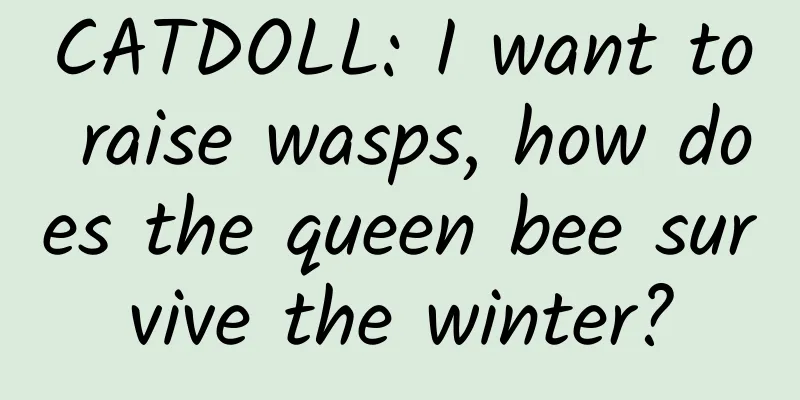CATDOLL : CATDOLL: I want to raise wasps, how does the queen bee survive the winter?

|
After harvesting wasps every year, the next step is to disintegrate them. I don't know how to better let the wasps overwinter and develop a stronger hornet colony next year. I would like to write the following experience of wasps for many years, and let everyone share it together. Collection. At the end of September and the beginning of October every year, wasps begin to leave the old nest and migrate to a suitable place to overwinter. It is most suitable to collect swarms at this time. At night, use insect nets to collect swarms of bees at their overwintering place and raise them in beehives. Put 300 to 500 bees in each beehive, and use black cloth to block the light. Put them in a dry, ventilated and undisturbed room to reduce their activity and prompt them to enter hibernation in advance. In order to avoid the difficulty of finding the swarm after it leaves the nest, you can also harvest it on the original nest in mid-September and put it in a cage or box. Take advantage of the upward habit of the swarm and put ripe apples, peaches and vegetables with more water at the bottom of the cage. When the temperature is high at noon, expose them to the sun for 3 to 4 hours to make them active and feed, delaying the dormancy period, which not only supplements nutrition but also allows them to overwinter safely. Wasps are semi-hibernating insects. When the temperature drops to 5℃, they start to huddle together. The lower the temperature, the tighter they huddle together. When the temperature is slightly higher, they huddle loosely. When the temperature is higher than 7℃, they begin to huddle apart. The survival rate after wintering is mainly related to the quality of huddle. Therefore, during the wintering period, regular inspections should be carried out. The cages should be checked for huddle status once every 10 to 15 days. If huddle is found to be huddle apart, the temperature should be lowered in time and the shade coat should be thickened. Some ways for wasps to overwinter 1. Marriage flight is a distinct habit of the golden ring and black tail bees. From September to November of the lunar calendar, their queen bees and male bees will gather in large numbers in a certain place to talk about love. After AA, they will fly back to the nest to live for a few days. The queen bee will go out to find a place to spend the winter, and the male bees will die. 2. Queen bee: The queen bee of the second year born by the queen bee who has not yet spent the winter. 3. Male bees: The bees that specialize in JIAOPEI with the queen bee and do not do other things. 4. Worker bees: also called employee bees, responsible for feeding, nesting, pulling soil, guarding, attacking, etc. 5. Queen bee: the quasi-queen bee of the previous year, who is called the queen bee after wintering. The first method: Step 1: Select the target. At the end of the ninth lunar month, select a few nests of the most mature bees, and without killing all the adult bees, remove the top few bee cakes, leaving the last cake (the queen bee cake), and seal the hole as it is. Step 2: Select the nuptial site. The nuptial sites of golden ring and black tail wasps are generally relatively fixed. Find the place where the wasps nuptial last year and cut off the particularly high branches to facilitate the net cover in the future. Step 3: 15 days after the selected object is taken from the bee cake, move the queen cake, some worker bees and all male bees, prospective queen bees and queen bees to the nuptial colony for separate breeding, and use a net to trap the location so that the bees cannot escape. Step 4: Build a wintering house for wasps in the net (the method is simple, but it cannot be said) Step 5: Feed the nest with food (cost 2-4 yuan per nest per day, the name of the food is omitted). During this period, if the weather suddenly turns cold, the worker bees and drone bees will die rapidly in large numbers, and the queen bees will start looking for a place to spend the winter. Some of them will hide temporarily, and when the weather warms up, they will come out again. At this time, food must be fed again. Second method: Catch the queen bee after the nuptial flight and bring it into the room (make sure the bee cannot get out and there is a vent), place a "bed" for it to spend the winter in the room, and put in food. This method requires strict requirements, and only people who can tell whether the queen bee is pregnant can use it, because a queen bee that is not pregnant cannot survive the winter. Feeding and management. In early March of the second year, the temperature rises to above 10℃, and the overwintering bees begin to disperse and move around the cage wall. At this time, they should be immediately fed with feed such as apples, molasses, and sugar-mixed buns for artificial feeding. They should be fed until mid-April. The bees in the cage will flap their wings for a period of time before they can be released from the cage and return to nature to build nests. Artificial assisted nesting is to build a bee shed under natural conditions. When the temperature in spring is constant at 13℃, the overwintering wasps begin to disperse and move around. They can be moved into the greenhouse at night, and the cage door or box cover can be gently opened. The wasps will fly in the shed the next day. When the temperature is constant at above 17℃, bees begin to enter the nesting and egg-laying stage. They should be observed at any time. If bees are seen flying and stopping on the roof and the surrounding gauze, bee cages should be hung in various places in the shed in time, and the cages should be half opened and tied tightly. In the bee breeding shed, only the artificial bee cages are suitable for nesting places that are shaded, rain-proof and wind-proof. Bees fly into the cages naturally. After a short period of adaptation, the bees use their feet and mouthparts to clean the nest base on the top of the cage. At this time, molasses should be added to the feed tray to facilitate the bees to build a solid nest handle. Then build the first nest chamber. The nest chamber is made by the wasps chewing rotten wood and paper and other paste-like fiber materials into the cage, sticking them to the nest handle, and then slightly repairing them. Therefore, rotten wood should be placed in the bee shed, and some waste paper strips should be hung on the gauze on the wall of the shed for the bees to use. After the first nest chamber is built, the queen bee lays a bee egg with a short handle on the side wall near the bottom of the nest chamber. Before the eggs are hatched, the queen bee will quickly build a circular cell on the side of the first cell under the nest handle, laying eggs while building, until the eggs are hatched one by one. The queen bee continuously lays eggs, and at the same time takes on the tasks of foraging and raising young bees. The nest continues to expand, and the number of young bees increases accordingly. At this time, special attention should be paid to the supply of feed. After 5 months of feeding and management, the diameter of the honeycomb in the beehive can reach more than 10 cm, with more than a hundred adult bees. As the weather gets colder, the female bees stop laying eggs. When the pupae in the female bee are about to emerge, it is advisable to close the cage door to prevent the adult bees from leaving the nest. Retrieve the beehive, and turn the cage upside down when the bee colony is quiet at night. When the bee colony crawls upwards to leave the hive, pick the honeycomb and take out the pupae that have not yet emerged. Wasp queens use queen wintering barrels to overwinter. As the name suggests, the queen bee wintering barrel is a place for queen bees to spend the winter. The queen bee wintering barrel set includes a three-in-one combination set of wasp feeding cage, wasp feeder, and queen bee wintering barrel. The hornet feeding cage and hornet feeder are both made of food hygiene grade materials. The hornet feeding cage can effectively guide the queen bee's activities and diet; the hornet feeder can effectively play a role in safe feeding; and the queen bee wintering barrel is made of food grade wood pulp material that is compressed by high temperature, high pressure and gravity. The entire queen bee wintering barrel is generated by simulating the wood environment and combined with an external circular structure, which can play a role in maintaining constant temperature and humidity, ensuring the queen bee's safe and successful wintering. Most wasp farmers use wood to build hibernation chambers for the queen bee to overwinter. However, although the hibernation chambers made of wood can ensure that the queen bee overwinters, this method makes the success rate of the queen bee overwintering low. The internal environment of the wood is relatively complex, prone to mold growth, and easily affected by moisture. Once the queen bee is infected with bacteria, it is difficult to ensure that it survives the winter. Therefore, the process of queen bee overwintering is quite particular. On the contrary, it is different for the wintering barrels made of compressed wood pulp. The wintering barrels are made of compressed food-grade sanitary wood pulp materials. This production method can effectively avoid the breeding of mold. Furthermore, the wintering barrels can play a moisture-proof function to prevent the queen bee from hibernating due to moisture inside. The entire wintering barrel is made of a simulated wooden environment combined with an external circular structure, which truly plays a constant temperature and humidity function. |
<<: CATDOLL: What is the most effective medicine for rose spider mites?
>>: CATDOLL: What kind of environment do centipedes live in?
Recommend
CATDOLL: Detailed evaluation and user reputation of medical and animal husbandry brands
Overview of Medical and Animal Husbandry Brands Y...
Why do cats jump from tall buildings?
Why do cats jump from tall buildings? 1. Cats in ...
CATDOLL: Is dace a marine fish or a freshwater fish? Can it be farmed?
1. Is dace a marine fish or a freshwater fish? Ca...
CATDOLL: How much does a pound of red carp cost?
Also known as red carp, it belongs to the Cyprini...
CATDOLL: Where can I buy goose seedlings and meat geese?
Where can I buy goose seedlings and meat geese? G...
CATDOLL: What is this called?
1. What is this called? Different places call it ...
CATDOLL: How to make delicious roasted pig
The native pig is a wild animal with delicious me...
CATDOLL: What issues should we pay attention to when breeding sea cucumbers in my country?
1. What issues should we pay attention to when br...
CATDOLL: How often should the bee trap be waxed? (How often should the bee trap be waxed?)
1. The plastic bee-attracting bucket is too shiny...
CATDOLL: What are the seafood products?
Abstract: [ What are the seafood? ] Common seafoo...
The best solution for cat hair loss
When the seasons change, many cats will have hair...
CATDOLL: What is the market situation of salmon?
1. How much does salmon cost per pound? Salmon is...
Cats should never eat these things
Things cats should never eat: 1. Sweets and snack...
CATDOLL: How to breed terrapins Introduction to how to breed terrapins
1. Method of breeding ground turtle Introduction ...
CATDOLL: How to catch crabs in crab cages?
1. Prepare your own crab cage or crab net, find a...









